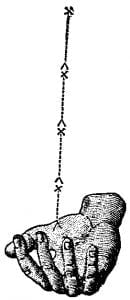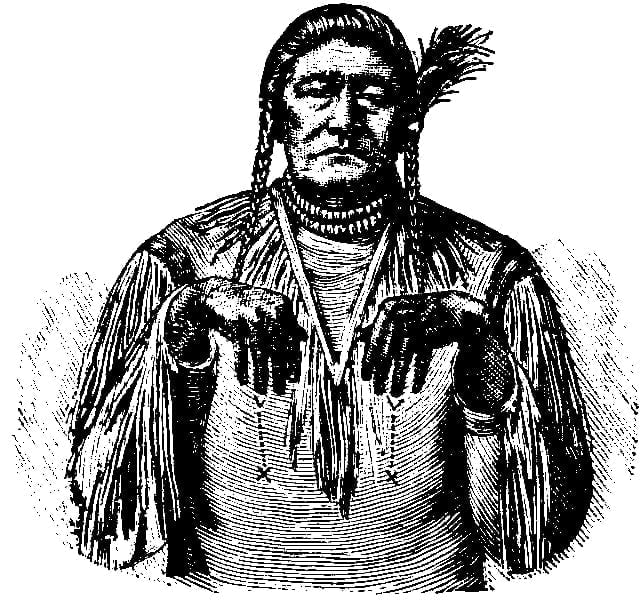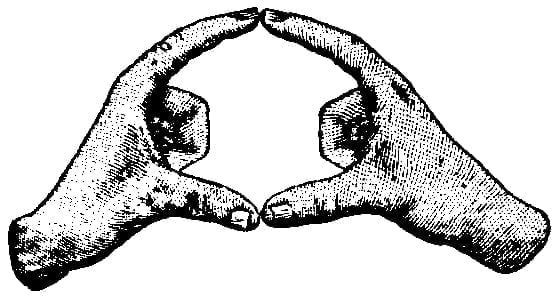While there is not sufficient evidence that any exhibition of sign language in any tribe is a dialect derived or corrupted from an ascertained language in any other tribe, it still is convenient to consider the different forms appearing in different tribes as several dialects (in the usual mode of using that term) of a common language. Every sign talker necessarily has, to some extent, a dialect of his own. No one can use sign language without original invention and without modification of the inventions of others; and all such new inventions and modifications have a tendency to spread and influence the production of other variations. The diversities thus occasioned are more distinct than that mere individuality of style or expression which may be likened to the differing chirography of men who write, although such individual characteristics also constitute an important element of confusion to the inexperienced observer. In differing handwriting there is always an attempt or desire to represent an alphabet which is essentially determinate, but no such fixedness or limited condition of form restricts gesture speech.
Those variations and diversities of form and connected significance specially calling for notice may be: 1st. In the nature of synonyms. 2d. Substantially the same form with such different signification as not to be synonymous. 3d. Difference in significance produced by such slight variation in form as to be, to a careless observer, symmorphic.
Synonyms
In this division are placed signs of differing forms which are used in senses so nearly the same as to have only a slight shade of distinction, or sometimes to be practically interchangeable. The comprehensive and metaphorical character of signs renders more of them interchangeable than is the case with words; still, like words, some signs with essential resemblance of meaning have partial and subordinate differences made by etymology or usage. Doubtless signs are purposely selected as delineating the most striking outlines of an object, or the most characteristic features of an action; but different individuals, and likewise different bodies of people, would not always agree in the selection of those outlines and features. Taking the illustration of the attempt to invent a sign for bird, before used, any one of a dozen, signs might have been agreed upon with equal appropriateness, and, in fact, a number have been so selected by several individuals and tribes, each one, therefore, being a synonym of the other. Another example of this is in the signs for deer, designated by various modes of expressing fleetness, by his gait when not in rapid motion, by the shape of his horns, by the color of his tail, and sometimes by combinations of several of those characteristics. Each of these signs may be indefinitely abbreviated, and therefore create indefinite diversity. Another illustration, in which an association of ideas is apparent, is in the upward raising of the index in front of and above the head, which means above (sometimes containing the religious conception of heaven, great spirit, &c.), and also now, to-day. Not unfrequently these several signs to express the same ideas are used interchangeably by the same people, and some one of the duplicates or triplicates may have been noticed by separate observers to the exclusion of the others. On the other hand, they might all have been noticed, but each one among different bodies. Thus confusing reports would be received, which might either be erroneous in deducing the prevalence of particular signs or the opposite. Sometimes the synonym may be recognized as an imported sign, used with another tribe known to affect it. Sometimes the diverse signs to express the same thing are only different trials at reaching the intelligence of the person addressed. An account is given by Lieut. Heber M. Creel, Seventh Cavalry, U.S.A., of an old Cheyenne squaw, who made about twenty successive and original signs to a recruit of the Fourth Cavalry to let him know that she wanted to obtain out of a wagon a piece of cloth belonging to her, to wipe out an oven preparatory to baking bread. Thus by tradition, importation, recent invention, or from all these causes together, several signs entirely distinct are produced for the same object or action.
This class is not intended to embrace the cases common both to sign and oral language where the same sign has several meanings, according to the expression, whether facial or vocal, and the general manner accompanying its delivery. The sign given, for “stop talking” on page 339 may be used in simple acquiescence, “very well,” “all right!” or for comprehension, “I understand;” or in impatience, “you have talked enough!” which may be carried further to express actual anger in the violent “shut up!” But all these grades of thought accompany the idea of a cessation of talk. In like manner an acquaintance of the writer asking the same favor (a permission to go through their camp) of two chiefs, was answered by both with the sign generally used for repletion after eating, viz., the index and thumb turned toward the body, passed up from the abdomen to the throat; but in the one case, being made with a gentle motion and pleasant look, it meant, “I am satisfied,” and granted the request; in the other, made violently, with the accompaniment of a truculent frown, it read, “I have had enough of that!” But these two meanings might also have been expressed by different intonations of the English word “enough.” The class of signs now in view is better exemplified by the French word souris, which is spelled and pronounced precisely the same with the two wholly distinct and independent significations of smile and mouse. From many examples may be selected the Omaha sign for think, guess, which is precisely the same as that of the Absaroka, Shoshoni and Banak for brave, see page 414. The context alone, both of the sign and the word, determines in what one of its senses it is at the time used, but it is not discriminated merely by a difference in expression.
It would have been very remarkable if precisely the same sign were not used by different or even the same persons or bodies of people with wholly distinct significations. The graphic forms for objects and ideas are much more likely to be coincident than sound is for similar expressions, yet in all oral languages the same precise sound is used for utterly diverse meanings. The first conception of many different objects must have been the same. It has been found; indeed, that the homophony of words and the homomorphy of ideographic pictures is noticeable in opposite significations, the conceptions arising from the opposition itself. The differentiation in portraiture or accent is a subsequent and remedial step not taken until after the confusion has been observed and become inconvenient. Such confusion and contradiction would only be eliminated if sign language were absolutely perfect as well as absolutely universal.
Symmorphs
In this class are included those signs conveying different ideas, and really different in form of execution as well as in conception, yet in which the difference in form is so slight as practically to require attention and discrimination. An example from oral speech may be found in the English word “desert,” which, as pronounced “des’-ert” or “desert’,” and in a slightly changed form, “dessert,” has such widely varying significations. These distinctions relating to signs require graphic illustration.

Tree, Grass, Grow
The sign made by the Dakota, Hidatsa, and several other tribes, for tree is made by holding the right hand before the body, back forward, fingers and thumb separated, then pushing it slightly upward, Fig. 112. That for grass is the same made near the ground; that for grow is made like grass, though instead of holding the back of the hand near the ground the hand is pushed upward in an interrupted manner, Fig. 113.

Smoke, Fire
For smoke, the hand (with the back down, fingers pointing upward as in grow) is thrown upward several times from the same place instead of continuing the whole motion upward. Frequently the fingers are thrown forward from under the thumb with each successive upward motion. For fire, the hand is employed as in the gesture for smoke, but the motion is frequently more waving, and in other cases made higher from the ground.
Rain, Heat, Weep
The sign for rain, made by the Shoshoni, Apache, and other Indians, is by holding the hand (or hands) at the height of and before the shoulder, fingers pendent, palm down, then pushing it downward a short distance, Fig. 114. That for heat is the same, with the difference that the hand is held above the head and thrust downward toward the forehead; that for to weep is made by holding the hand as in rain, and the gesture made from the eye downward over the cheek, back of the fingers nearly touching the face.

Sun, Want, Drink, Money
The common sign for sun is made by bringing the tips of the thumb and index together so as to form a circle; remaining fingers closed. The hand is then held toward the sky, Fig. 115. The motion with the same circular position of index and thumb is for want, by bringing the hand backward toward the mouth, in a curve forming a short arch between the origin and termination of the gesture.For drink the gesture by several tribes is the same as for want, with the slight difference in the position of the last three fingers, which are not so tightly clinched, forming somewhat the shape of a cup; and that for money is made by holding out the hand with the same arrangement of fingers in front of the hips, at a distance of about twelve or fifteen inches.

Sun, Various Things, Village
Another sign for sun, made by the Cheyennes, is by placing the tips of the partly separated thumb and index of one hand against those of the other, approximating a circle, and holding them toward the sky, Fig. 116, and that for various things, observed among the Brulé Sioux with the same position of the hands, is made by placing the circle horizontal, and moving it interruptedly toward the right side, each movement forming a short arch. Compare also the sign for village.

Soldier, Done, Much, To Be Told, Give / Asking
The Arikara sign for soldier is by placing the clinched hands together before the breast, thumbs touching, then drawing them horizontally outward toward their respective sides, Fig. 117. That for done, made by the Hidatsa, is shown below in this paper, see Fig. 334, page 528. That for much (Cheyenne I, Comanche III), see Fig. 274, page 447, is to be correlated with the above.The sign for to be told or talked to, and for the reception of speech, by the tribes generally, is made by placing the flat right hand, palm upward, about fifteen inches in front of the right side of the face or breast, fingers pointing to the left, then drawing the hand toward the bottom of the chin, and is illustrated in Fig. 71, page 291. The Comanche sign for give or asking is shown in Fig. 301, page 480 (Comanche III), and is made by bringing the hand toward the body but a short distance, and the motion repeated, the tips of the fingers indicating the outline of a circle.

Kaiowa, Deer, Food
The tribal sign for Kaiowa, illustrated in its place among the Tribal Signs, is made by holding the hand with extended and separated fingers and thumb near the side of the head, back outward, and giving it a rotary motion. This gesture is made in front of the face by many tribes. The generic sign for deer, made by the Dakota and some others, is by holding the hand motionless at the side of the head, with extended and separated thumb and fingers, representing the branched antlers. That for fool, reported from the same Indians, is the same as above described for Kaiowa, which it also signifies, though frequently only one or two fingers are used.
Sahaptin, Nez Percés, Caddo, Lie / Falsehood
The tribal sign both for the Sahaptin or Nez Percés and for Caddo (see Tribal Signs) is made by passing the extended index, pointing under the nose from right to left. When the second finger is not tightly closed it strongly resembles the sign often made for lie, falsehood, by passing the extended index and second fingers separated toward the left, over the mouth.
Cheyenne
The tribal sign for Cheyenne (see Tribal Signs) differs from the sign for spotted only in the finger (or hand) in the latter being alternately passed across the upper and lower sides of the left forearm.
Steal / Theft, Bear
The sign for steal, theft, see Fig. 75, page 293, is but slightly different from that for bear, see Fig. 239, page 413, especially when the latter is made with one hand only. The distinction, however, is that the grasping in the latter sign is not followed by the idea of concealment in the former, which is executed by the right hand, after the motion of grasping, being brought toward and sometimes under the left armpit.
Cold / Winter, Love, Prisoner
Cold and winter, see Tendoy-Huerito Dialogue, page 486, may be compared with love, see Kin Chē-ĕss’ speech, page 521, and with prisoner. In these the difference consists in that cold and winter are represented by crossing the arms with clinched hands before the breast; love by crossing the arms so as to bring the fists more under the chin, and prisoner by holding the crossed wrists a foot in front of the breast.
Melon / Squash / Muskmelon, Animals
Melon, squash, muskmelon, used by the Utes and Apaches, is made by holding the hand arched, fingers separated and pointing forward, and pushing the hand forward over a slight curve near the ground, and the generic sign for animals by the Apaches is made in the same manner at the height intended to represent the object.
Where / To Search / To Seek For, Some of Them
The sign for where?, and to search, to seek for, made by the Dakota (IV), is by holding the back of the hand upward, index pointing forward, and carrying it from left to right about eight inches, raising and lowering it several times while so doing, as if quickly pointing at different objects. That for some of them, a part of a number of things or persons, made by the Kaiowa, Comanche, Wichita, and Apache Indians is nearly identical, the gesture being made less rapidly.
